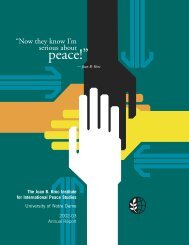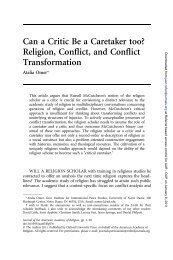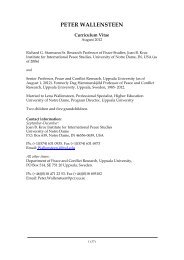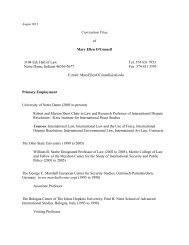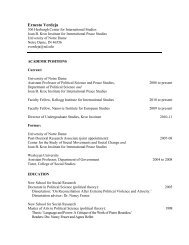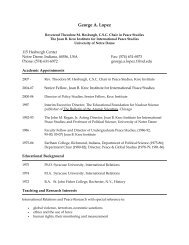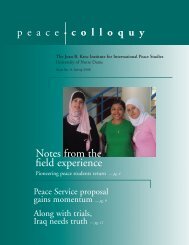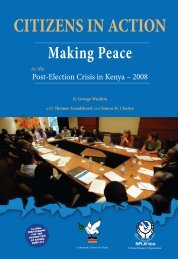Somalia: Creating Space for Fresh Approaches to Peacebuilding
Somalia: Creating Space for Fresh Approaches to Peacebuilding
Somalia: Creating Space for Fresh Approaches to Peacebuilding
You also want an ePaper? Increase the reach of your titles
YUMPU automatically turns print PDFs into web optimized ePapers that Google loves.
(i.e. civil war or humanitarian crises), but also by its use of positive frames that<br />
allow <strong>for</strong> the possibility of conflict trans<strong>for</strong>mation.<br />
impact of international media in somalia<br />
The framing of <strong>Somalia</strong><br />
In order <strong>to</strong> analyze and compare the frames that the international and African<br />
media have used when portraying <strong>Somalia</strong>, this paper looks at the New York<br />
Times (NYT) and the website allAfrica.com. Between 2000 and 2010, NYT has<br />
written nearly 2,500 articles that mention <strong>Somalia</strong>. This news source is respected<br />
within the Western world and is used as a sample <strong>for</strong> Western media reporting.<br />
AllAfrica.com is a service that collects and disseminates news articles from more<br />
than 130 African news organizations, and is used as a sample of African media<br />
reporting. They have featured more than 30,000 articles on <strong>Somalia</strong> during the<br />
same ten years.<br />
A qualitative analysis of article headlines was used <strong>to</strong> develop a list of common<br />
or interesting key words that were being used <strong>to</strong> describe the situation in<br />
<strong>Somalia</strong>. Michael Parenti argues fram-<br />
Potential Frames<br />
1. Civil war<br />
2. Humanitarian crisis<br />
3. Local peacebuilding ef<strong>for</strong>ts<br />
4. Warlords<br />
5. Terrorism/Al-Qaeda<br />
6. Piracy<br />
7. Natural disaster<br />
8. Islamic insurgency<br />
9. Peace talks/Agreement<br />
10. Peacekeeping missions<br />
ing is achieved in part through the use of<br />
particular labeling and vocabulary. The<br />
repetitive use of specific terms by a news<br />
outlet constitutes a frame that “conveys<br />
positive or negative cues regarding events<br />
and persons”. 14 In this case, ten different<br />
ways of framing the situation (see<br />
Figure 1), based on those key words, were<br />
compared across the two news sources by<br />
counting the number of articles that used<br />
the terms in each six-month time period<br />
from 2000-2010. 15 While a keyword search<br />
is an imperfect way <strong>to</strong> conduct a content<br />
analysis of news media, it does give a gen-<br />
eral idea about how the Somali conflict is being framed.<br />
<strong>Somalia</strong> was most often referred <strong>to</strong> by the NYT with respect <strong>to</strong> terrorism,<br />
with 45 percent of the articles mentioning terrorism or al-Qaeda. 16 The African<br />
sources on the other hand, only wrote about terrorism or al-Qaeda in 16 percent<br />
of their <strong>Somalia</strong> articles. Other popular frames used by the NYT included that of<br />
a humanitarian crisis, a civil war or a peacekeeping operation. Peace processes<br />
were only mentioned in 5.8 percent of the articles, while local peacebuilding<br />
ef<strong>for</strong>ts, represented by the key words “civil society” and “grassroots”, were only<br />
mentioned in 12 out of the 2,500 articles. While allAfrica.com’s sources were also<br />
most likely <strong>to</strong> refer <strong>to</strong> terrorism, humanitarian crises, civil war and peacekeeping<br />
operations in their articles, they were also twice as likely <strong>to</strong> mention peace<br />
processes and more than six times more likely <strong>to</strong> write about local peacebuilding<br />
ef<strong>for</strong>ts than was the NYT. A comparison between the two sources on each frame<br />
can be seen in Table 1.<br />
14 Parenti, Michael, Inventing<br />
Reality: The Politics of the Mass<br />
Media, (New York, NY: St. Martin’s<br />
Press, 1986): p. 220.<br />
15 The key word search was<br />
conducted through WestLaw. The<br />
key words used <strong>to</strong> constitute each<br />
frame can be seen in Appendix 1.<br />
16 Note that the link between<br />
al-Qaeda and al-Shabaab was<br />
generally assumed by the United<br />
States since the country declared<br />
al-Shabaab a terrorist organization<br />
in 2008. According <strong>to</strong> the Council<br />
on Foreign Relations actual links<br />
between the two organizations<br />
prior <strong>to</strong> 2010 were weak, if present<br />
at all. Yet the media tended <strong>to</strong><br />
rein<strong>for</strong>ce without question the US<br />
claims of a connection between the<br />
organizations. (Hanson, Stephanie,<br />
“Backgrounder on Al-Shabaab”,<br />
Council on Foreign Relations,<br />
2011, Available online http://<br />
www.crf.org/somalia/al-shabaab/<br />
p18650#p4). In February 2010, al-<br />
Shabaab declared <strong>for</strong> the first time<br />
that the organization was in fact<br />
aligned with al-Qaeda’s campaign<br />
of global jihadism. (See “Somali<br />
Islamists al-Shabab ‘join al-Qaeda<br />
fight’”, BBC News, 1 February 2010,<br />
Available online ; Childress, Sarah, “<strong>Somalia</strong>’s<br />
Al-Shabaab <strong>to</strong> Ally with Al Qaeda”,<br />
Wall Street Journal, 2 February<br />
2010, Available online ; Yusuf, Huma,<br />
“Somali militant group Al Shabab<br />
aligns with Al Qaeda”, The Christian<br />
Science Moni<strong>to</strong>r, 2 February 2010,<br />
Available online ).<br />
55




